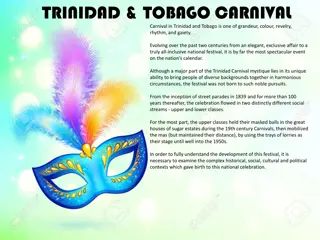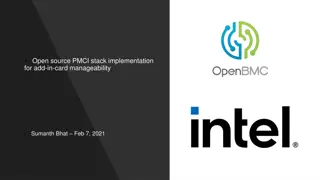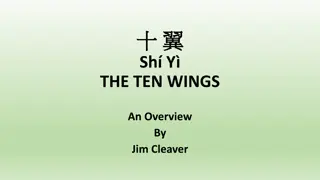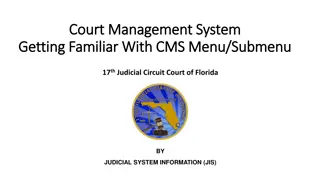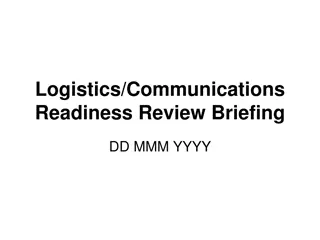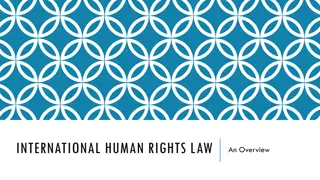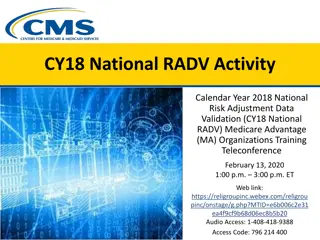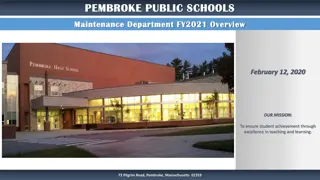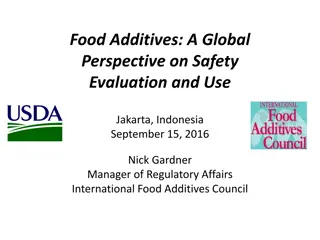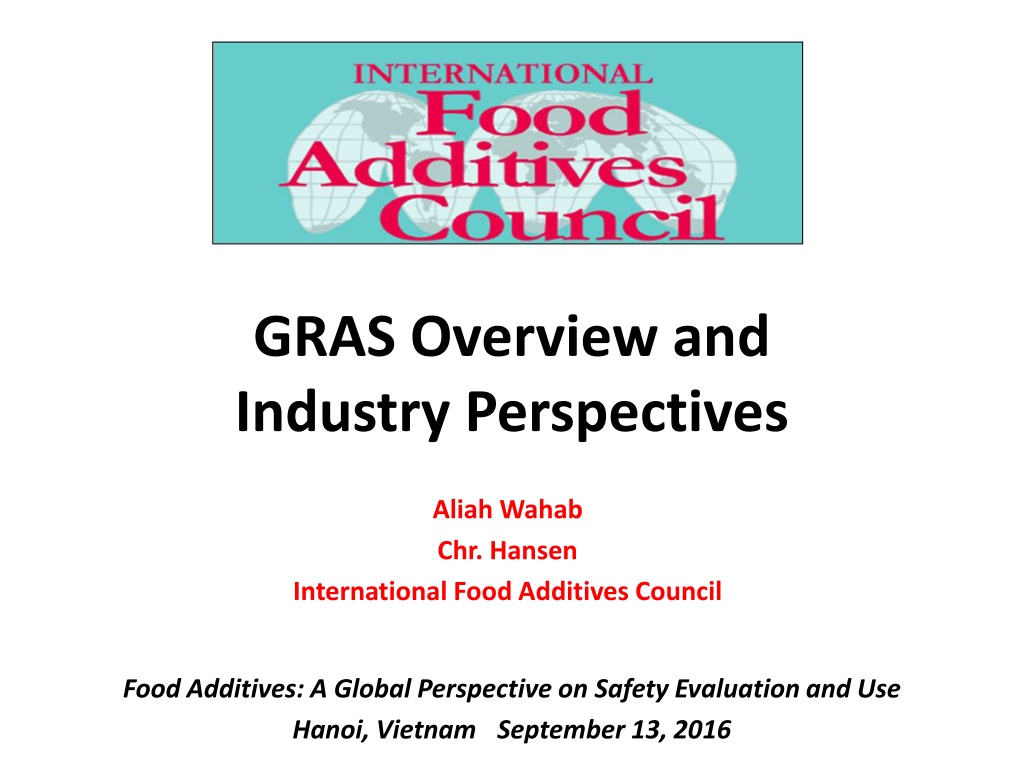
Understanding GRAS Process and Food Additive Regulations in the U.S.
Learn about the safety evaluation of food ingredients, GRAS determinations, food additive petition process, and GRAS notifications in the U.S. Understand the criteria for substances to be Generally Recognized as Safe (GRAS) and the regulatory background for food additives.
Download Presentation

Please find below an Image/Link to download the presentation.
The content on the website is provided AS IS for your information and personal use only. It may not be sold, licensed, or shared on other websites without obtaining consent from the author. Download presentation by click this link. If you encounter any issues during the download, it is possible that the publisher has removed the file from their server.
E N D
Presentation Transcript
GRAS Overview and Industry Perspectives Aliah Wahab Chr. Hansen International Food Additives Council Food Additives: A Global Perspective on Safety Evaluation and Use Hanoi, Vietnam September 13, 2016
Presentation Overview U.S. Food Additive and GRAS Regulatory Background U.S. Food Additive Petition Process U.S. GRAS Process GRAS Determinations GRAS Notifications Value of GRAS Ensuring a Robust GRAS Process Conclusion
Safety Evaluation of Food Ingredients in the U.S. According to the U.S. FDA, the term safemeans that there is reasonable certainty in the minds of competent scientists that a substance is not harmful under the intended conditions of use. The term food additiverefers to any substance that the intended use of which results or may reasonably be expected to result -- directly or indirectly -- in its becoming a component or otherwise affecting the characteristics of any food. A substance is Generally Recognized as Safe or GRASif it is generally recognized, among qualified experts, as having been adequately shown to be safe under the conditions of its intended use, or unless the substance is otherwise excluded from the definition of a food additive.
Food Additives and GRAS Background In the U.S., substances are added to food through: Food Additive Petition GRAS Determination OR GRAS Notification
Food Additive Petition Process For new substances, substances not considered GRAS, and/or substances without a long history of safe use Petitioner develops a petition and submits to U.S. FDA with all supporting toxicological data (publicly and privately available) Public rulemaking process enhances transparency After U.S. FDA review, a notice appears in the Federal Register for public review/comment; specifies the conditions of use Once approved, food additives appears in the Code of Federal Regulations (21 CFR Part 172) Burden to determine safety primarily rests with U.S. FDA Slow Process: take years
GRAS Process GRAS determinations may be based only on the views of experts qualified by scientific training and experience to evaluate the safety of substances directly or indirectly added to food. (21 CFR 170.30) GRAS determinations require scientific evidence of equivalent quantity and quality as that needed for a Food Additive Petition All data to support the GRAS determination must be publicly available More Timely, less Burdensome on U.S. FDA, promotes innovation and allows for faster time to market Burden to prove safety primarily rests with the company Unique to the U.S.
GRAS Determinations Company takes GRAS position based on common knowledge and general acceptance among qualified experts that a substance is safe for its intended use Company is not required to inform FDA of its GRAS determination (i.e., independent determination ) All data to support independent determination must be publicly available GRAS determinations require scientific evidence of equivalent quantity and quality as that needed for a Food Additive Petition IFAC member companies typically use an expert panel for safety determination
GRAS Notifications Additional step companies may voluntarily take to enhance transparency Company informs U.S. FDA of its GRAS determination and provides all supporting information to FDA Most information to establish GRAS status must be publicly available Does not require public rulemaking process Manufacturer may meet with FDA prior to notification to review dossier and ask questions (FDA encourages) FDA reviews notification and responds with a letter stating: 1. FDA has no questions 2. The notifier has not provided a basis that the substance is GRAS, 3. FDA has ceased to review the notification at the request of the notifier U.S. GRAS Notice Inventory lists substances that have been notified since 1998; some GRAS substances are listed in 21 CFR Part 184
Additional GRAS Considerations FDA s final rule clarifies and strengthens the oversight by better explaining how general recognition of safety is determined U.S. FDA recently completed rulemaking on GRAS rule- impacts self-GRAS and GRAS notifications IFAC believes the GRAS process works well for industry and FDA; IFAC is supportive of the final rule IFAC developed a GRAS Best Practices Guide to demonstrate industry expectations for making GRAS determinations IFAC not aware of any safety concerns that have arisen from this process IFAC member companies typically use an expert panel for safety determination
Food Additive Petition vs. GRAS Processes Level of Evidence Safety Evidence in Public Domain? Public Rulemaking Process? Who Makes Safety Determination? Timing Food Additive Petition Same Not Required Yes US FDA Years GRAS Determination (not notified) Same Required No Company uses independent experts to make safety determination Weeks/ Months GRAS Notification Same Required No Experts make determination; FDA Issues No Questions Letter Months
Value of the GRAS Process Targeted Use of Limited U.S. FDA Resources Burden to prove safety rests primarily with industry Shorter review times and time to market Takes advantage of common knowledge element and history of safe use 1996: Backlog of food additive petitions & GRAS affirmation petitions led to calls for reform by President Clinton and the industry FDA Responses (as of September 2015) - 559 responses issued - 81% FDA has no questions - 3% Insufficient basis - 16% Notifier stops process 1958: FD&C Act Defines Food Additive (includes GRAS exclusion) December 2015: FDA has filed nearly 600 GRAS notices (averaging 30 notices/year) Early 1970s: FDA establishes formal GRAS-affirmation petition process Reference: Dr. Toni Mattia, US FDA
Value of the GRAS Process Market-driven innovation spurs demand for substances with functional/health benefits and/or desired technological functionality Facilitates faster market introduction of new and innovative products to meet consumer demand for convenient and healthier options Supports Innovation and Product Development Ensures safety while fostering innovation Average time for market clearance (excludes dossier preparation time) 14-18 months (expedited i.e., enhances food safety) >18 months Food additive petition GRAS notification (FDA review only) ~ 180 days (6 months) GRAS expert panel ~ 1 month
The Making of a GRAS Substance - Ensuring a robust GRAS process Identification and Characterization of the Substance Manufacturing Process Unit operations Raw Materials Chemically Defined vs. Natural Complexes Stability Reaction within food matrix Breakdown of products
The Making of a GRAS Substance - Ensuring a robust GRAS process Data to Assess Safety & Support a GRAS Claim Determining Safe Levels of Intake Literature search for all relevant information Fair & balanced Scope Post-launch product stewardship Monitor & re-evaluate Estimating Daily Intake/Exposure Market intelligence similar competitive products Existing history of use & use levels Background levels from natural sources
The Making of a GRAS Substance - Ensuring a robust GRAS process GRAS Expert Panel Training and Experience Qualification Standard FDA would normally look for such qualifications as training and experience in the relevant scientific disciplines, professional positions held, name recognition by fellow members of the scientific community and publications in respected journals in the field. Reference: Rulis, A and Levitt, J. FDA S food ingredient approval process: Safety assurance based on scientific assessment. Regulatory Toxicology and Pharmacology. 2009 Feb; 53(1):20-31. Independent Advisor vs. expert panel member Conflict of interest assessment SOP
Concluding Remarks Substances may be added to food in the U.S. through a Food Additive Petition or following the GRAS process. Food Additive Petitions require public rulemaking; GRAS determinations do not. GRAS determinations require scientific evidence of equivalent quantity and quality as that needed for a Food Additive Petition. The GRAS process is well established, brings value and works well. The food ingredient industry has a vested interest in ensuring a robust and well accepted food system, including the food additive and GRAS processes. The food industry has been and must continue to be diligent to ensure ingredients are safe, through the application of appropriate best practices and sound scientific principles. The food ingredient industry embraces initiatives to strengthen food safety that are based on sound science and desires to contribute to the discussion by sharing industry specific expert knowledge and concerns.
Helpful URLs IFAC website foodingredientfacts.org FDA Food Additive Petition process http://www.fda.gov/Food/IngredientsPackagingLabeling/FoodAdditivesIngredients/ Food Additives Permitted for Direct Addition to Food for Human Consumption https://www.accessdata.fda.gov/scripts/cdrh/cfdocs/cfcfr/CFRSearch.cfm?CFRPart=172 FDA Generally Recognized as Safe (GRAS) http://www.fda.gov/Food/IngredientsPackagingLabeling/GRAS/default.htm How to Submit a GRAS Notice http://www.fda.gov/Food/IngredientsPackagingLabeling/GRAS/ucm083062.htm U.S. GRAS Notice Inventory http://www.accessdata.fda.gov/scripts/fdcc/?set=GRASNotices
Questions? Thank you! Aliah Wahab Regional Regulatory Affairs Director APAC CHR. Hansen Singapore Pte Ltd. SGAAW@chr-hansen.com International Food Additives Council 750 National Press Building Washington, DC USA foodingredientfacts.org

![❤[READ]❤ Deep Space Craft: An Overview of Interplanetary Flight (Springer Praxis](/thumb/21511/read-deep-space-craft-an-overview-of-interplanetary-flight-springer-praxis.jpg)





